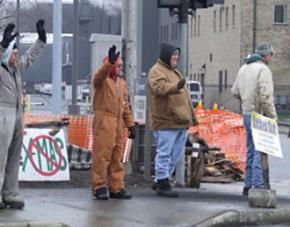When will labor draw a line?
looks at the challenges facing unions as employers keep up their attack.
IT'S TOUGH to exaggerate the scale of attacks on organized labor today--or the urgency of organizing an effective response from the union rank and file.
Just six months after labor took to the streets alongside the Occupy movement to protest corporate greed, social inequality and the domination of politics by big money, unions are once again on the defensive--from bipartisan legislative attacks on public-sector unions to the attempt by Corporate America to crush labor in its last remaining bastions in private industry.
The message from big business and its political counterparts couldn't be clearer. Unlike in the past, when employers usually asked for concessions on a temporary basis, workers now are expected to swallow a deep and permanent cut in their standard of living in order to enable U.S. capitalism to recover from its worst economic crisis since the 1930s.
And if workers don't like it? Someone else is waiting to take their jobs for even less money.
In response to this, labor's strategy--if you can call it that--is to double down on the Democratic Party.

Having looked to the election of President Barack Obama in the 2008 elections as the way to win labor law reform and rebuild unions, union leaders instead got a pay freeze for federal workers, legislation encouraging attacks on teachers' unions, right-to-work type organizing rules in the airline industry, and the threat of sweeping layoffs in the U.S. Postal Service. But the unions have already issued their inevitable endorsement for Obama's reelection.
If labor's get-out-the-vote operation in 2008 was based on hope, its 2012 efforts will be motivated purely by fear of the anti-labor policies of a Romney administration.
Certainly the Republicans are taking some of their harshest anti-labor stances in decades. Wisconsin Gov. Scott Walker, of course, set the pace with legislation stripping public-sector workers of their collective bargaining rights, and Michigan Gov. Rick Snyder followed suit with a similar measure. While Republicans were dealt a setback when a referendum defeated copycat legislation in Ohio, they pushed back in Indiana, ramming through so-called "right to work" legislation under Gov. Mitch Daniels earlier this year.
Yet Democrats are themselves carrying out similar attacks on public-sector unions. It was the Democratic mayor and city council in Detroit that used Michigan's new law to create an unaccountable special emergency board to impose sweeping concessions on unions.
California Gov. Jerry Brown has already extracted concessions from state workers, and New York Gov. Andrew Cuomo pushed legislation that cripples public employee pension funds. Illinois Gov. Pat Quinn is preparing to follow suit. Perhaps the leading Democratic labor-basher is Chicago Mayor Rahm Emanuel, who is bleeding municipal unions and mounting an all-out attack on the Chicago Teachers Union.
Even so, leaders of the biggest public-sector unions--the American Federation of State, County and Municipal Employees, the American Federation of Teachers and the National Education Association--are pouring still more resources into the Democrats' campaign coffers. That, unsurprisingly, only convinces Democrats they can get away with their anti-union agenda and never pay a price from unions.
The main difference is that where Republicans want to drain unions financially, Democrats want them to keep collecting dues--so they help finance Democratic campaigns.
LABOR LEADERS are pouring everything into the November elections and hoping for some relief in the future. But business is raising the stakes--right now and right away.
The front lines of the latest battle are at American Airlines and Hostess Brands, which are following the example of the auto companies by using bankruptcy court to try to dictate terms to unions--or void their collective bargaining agreements altogether.
Hostess wants the Teamsters to accept a cut in the company's pension contributions from $103 million to $25 million, rules allowing one delivery driver to do the work of two, and outsourcing of some deliveries.
American Airlines is going even further. It has asked a federal judge to simply void its union contracts in one fell swoop as the company aims to get $1.25 billion in concessions from workers, including a pension freeze and elimination of key work rules.
Even profitable companies are pushing demands that were unthinkable just a few years ago. At Verizon, where the Communications Workers of America (CWA) and International Brotherhood of Electrical Workers (IBEW) struck for two weeks last August, the company is engaging in regressive bargaining, demanding a wage freeze, a cap and cuts in pensions, high health care premiums for substandard plans, gutted job security and more. The unions continue to negotiate as they work without a contract.
And now the CWA and IBEW are facing similar demands from the other moneymaking industry giant, AT&T, which pulled in $20 billion in profits last year. Workers again stayed on the job after their collective bargaining agreement expired April 7. Following Verizon, AT&T wants its 40,000 unionized members to absorb 32 percent of the company's health care costs by the end of the contract, outstripping the wage gains that management proposes.
If Verizon and AT&T workers are keeping up the struggle, it's in part because of a fighting tradition in their unions and the size of the organized workforce, which, while down sharply in recent years, remains large.
By contrast, many union locals are finding themselves isolated and overwhelmed by the firepower that big companies can bring to bear. That was the case at a Cooper Tire plant in Ohio, where bosses imposed a long lockout that ended when members of United Steelworkers Local 207L voted to accept a contract that contained most of the concessions that they had originally rejected. A similar struggle has unfolded at American Crystal Sugar, where a lockout of the Bakery, Confectionery, Tobacco Workers and Grain Millers union that began last August continues with no end in sight.
Despite this onslaught, most unions still try--increasingly in vain--to preserve some form of labor-management "partnership" at almost any cost to their members. In fact, it is increasingly employers, rather than unions, who put workers on the picket lines. The number of lockouts has surged while strikes remain at near record-low levels.
Even though most union leaders have shown themselves willing to make major concessions in a bid to save jobs or simply preserve their unions, the bosses have refused to take "yes" for an answer and forced the struggle to a head. "This is a sign of increased employer militancy," Clark University professor Gary Chaison told the New York Times.
This effort to steamroll unions is taking place even as corporations run up profits to near record levels and the manufacturing sector adds jobs--developments that have usually given organized labor greater leverage to demand improvements in pay and development.
But not in this recovery: the upswing in auto production and profits, for example, is taking place in large part because of sweeping concessions, including lower-tier wages for new hires, taken by the United Auto Workers in the 2007 contract and again in the government bailout of the Detroit Three automakers two years later.
The downdraft from manufacturing industry wage cuts has put downward pressure on all workers' wages. As the Sentier Research firm points out, "For the entire period from December 2007 to June 2011, real median annual household income has declined by 9.8 percent. A decline of this magnitude represents a significant reduction in the American standard of living."
THIS INTENSIFICATION of the employers' offensive was the background to the Wisconsin labor uprising of 2011 and the labor-Occupy protests later that year.
Years of rising bitterness over unemployment, falling wages the housing crisis and more finally found a focal point as working people discovered that they were not alone in their struggles. From the mass rallies of union members and supporters at the Wisconsin state Capitol to the huge labor-backed marches in support of Occupy Wall Street in New York City, working people got a sense of their potential power.
But that sense of solidarity in the streets hasn't yet translated into struggle at the workplace--the point of production.
Some employers thought better of taking on unions at the height of the Occupy movement. The commercial building owners in New York dropped demands for harsh concessions and settled with the Service Employees International Union at the end of last year.
In the port of Longview, Wash., militant action by workers, along with solidarity from Occupy that included a partial West Coast port shutdown, helped to force grain giant EGT dropped its efforts to impose a scab operation on the docks. Although the company did manage to extract significant concessions from the International Longshore and Warehouse Union, the Longview workers managed to preserve their union--and they provided a glimpse of the kind of militant struggles it will take to rebuild a fighting labor movement.
Still, no labor activist can have any illusions about the difficulties of that wider challenge. Increasingly, employers and anti-union politicians are forcing struggles that literally put the existence of unions on the line. Anti-union laws effectively outlaw solidarity strikes, and pro-employer judges stand ready with injunctions that would financially cripple striking unions.
Furthermore, in the day-to-day struggle in the workplace, employers are more dictatorial than ever, as most unions' shop-floor organization has withered. And while opinion polls have shown that millions of workers in nonunion workplaces would join unions if they could, employers long ago bent labor laws to erect huge barriers to union organizing drives.
Nevertheless, there are currents within the U.S. labor movement that are systematically trying to build on the fighting spirit seen in Wisconsin and in Occupy.
Among the major unions in the AFL-CIO, National Nurses United has taken the lead in opposing concessions and shown itself willing to take strike action. The National Union of Healthcare Workers, formed after the Service Employees International Union (SEIU) seized control of its West Coast health care unit, has shown itself willing to use the strike weapon as it seeks to win over members from the pro-concession SEIU.
The progressive United Electrical workers union is pressing ahead in organizing workers in big Chicago-area warehouses, a key priority that bigger and better-financed unions have avoided. The reform leadership of the Chicago Teachers Union is preparing for a possible strike against Rahm Emanuel's anti-union offensive.
And this is only the tip of the iceberg. In the wake of Wisconsin, and through the formation of Occupy labor committees around the U.S., grassroots networks of union members are organizing within and between unions to promote a strategy of democratizing the unions and standing up to the boss. Some 1,500 of them are expected to gather in Chicago May 4-6 at the biannual Labor Notes conference to share their experiences and debate the next steps for the movement.
With the stakes in the struggle higher, the conference couldn't be more timely.


